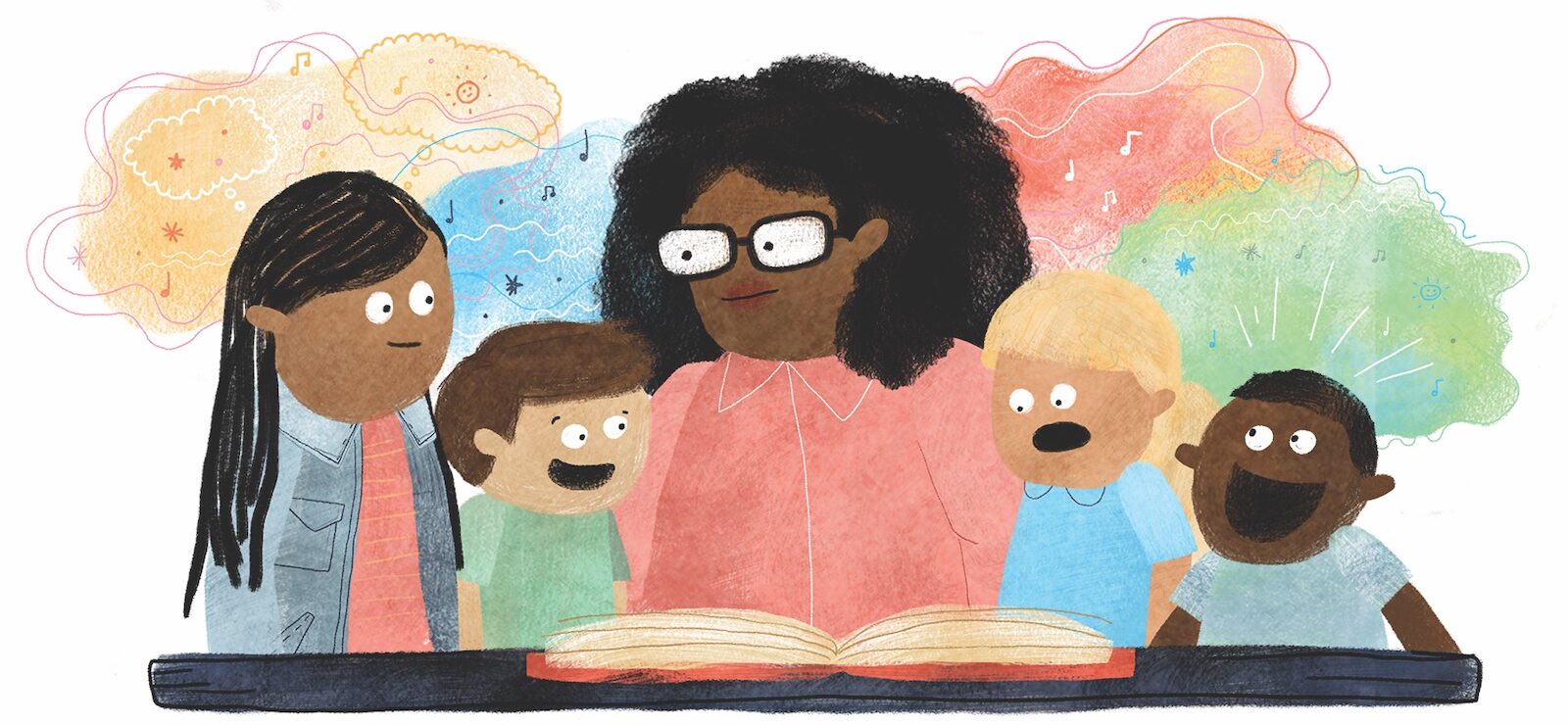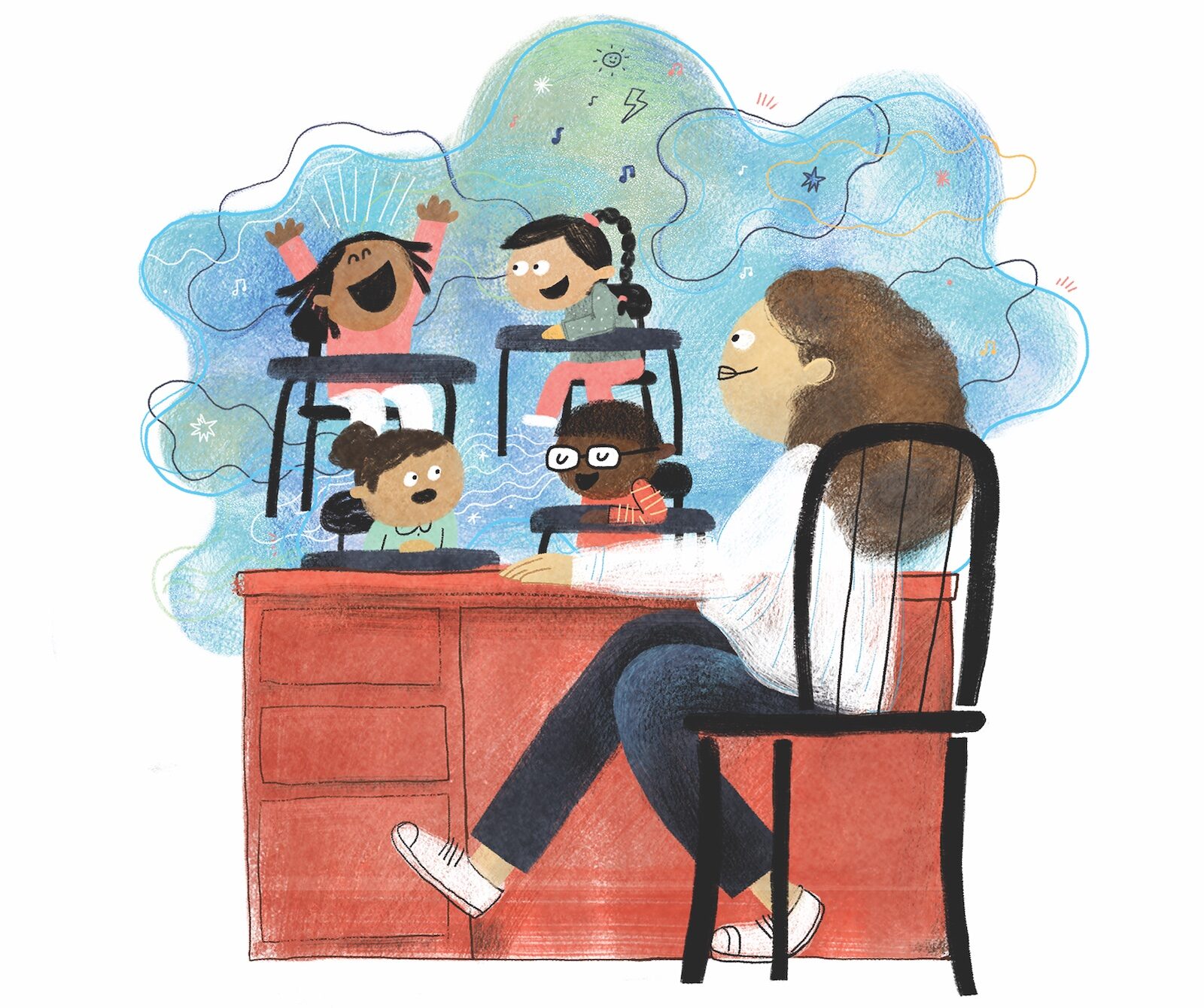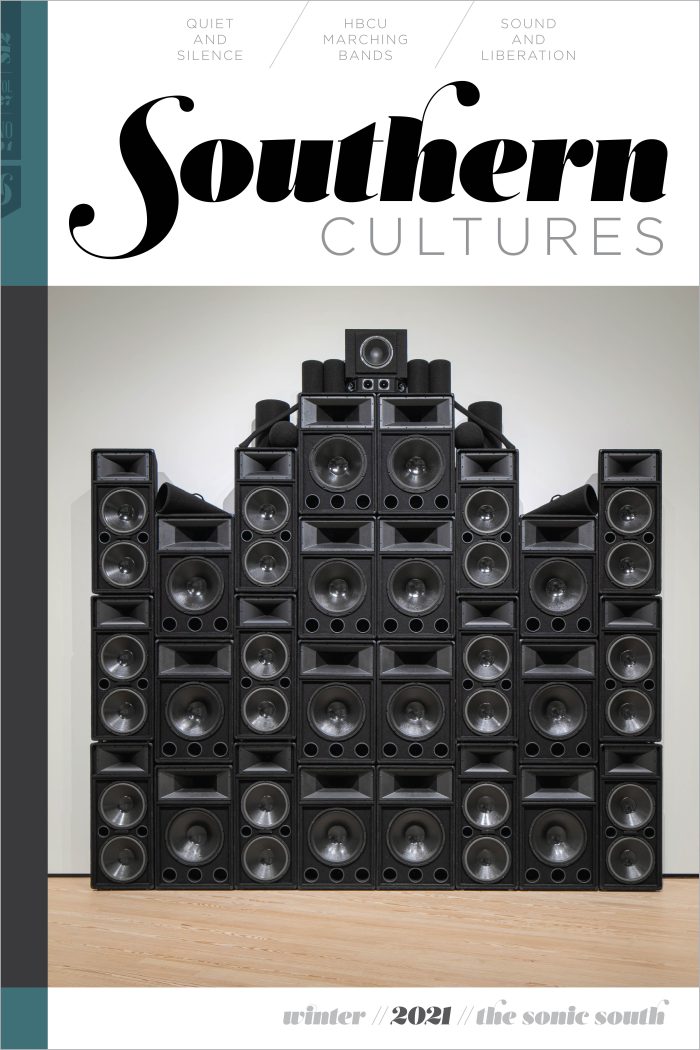Silence is both a noun and a verb—defined as the absence of sound and the prohibition of speech, respectively. Silence is a gift and a curse. It is a tool for liberation and a tool of oppression. Silence is complex; it can communicate both rest and labor, compliance and resilience, humility and pride. Silence is a provocative strategy used by the powerful to exclude the less powerful and render them voiceless, outside the dominant narrative. Simultaneously, however, it is a revolutionary tactic of reflection and imagination, used by the historically marginalized to develop and center their own stories. How we interpret and respond to silence speaks to our individual identities, our intersectional narratives, and our work as a community. We are a collective of Black educators in North Carolina fighting to dismantle an educational system rooted in white supremacy. Throughout this essay, we demonstrate how silence can be used as a pedagogical practice centering and amplifying the lived experiences of historically marginalized groups. Soundscapes are not monolithic, so the practices we use are diverse. In oppressive schooling spaces, we understand that educators must utilize both the presence and absence of sound to create soundscapes where silent mindfulness is harmless, wait time is sacred, racial identity is honored, and multiple perspectives are given voice.
This collection of short essays written by Black educators, teaching in the South nearly seventy years after the historic Brown v. Board of Education of Topeka decision that integrated public schools, seeks to break ongoing cycles of oppression by emphasizing the power of silence and challenging the reader to grapple with the multifaceted nature of soundscapes. Together, these essays isolate silence as the loudest sound.
Prior to the pivotal Brown v. Board ruling in 1954, Black schools affirmed and celebrated Blackness and Black culture through instruction, social programming, and activism. The school building was an extension of the community it served, in both literal and figurative ways, meeting the academic and social needs of students and their families. Teachers and students were neighbors, making way for learning experiences and opportunities that mirrored the soundscapes of Black homes with a small margin for misinterpretation.

Before integration, Black professional educators had the power to use Blackness and Black cultural references as an integral part of the teaching and learning process. The ancestors inaugurated oral, auditory, and kinesthetic techniques—call-and-response, music and singing, dance and body percussion—to engage young Black learners. Black educators were skilled at drawing on cultural funds of knowledge to push students toward academic and civic excellence. Further, these educators were leaders in the community, often organizing and marching for justice in regard to lynching, voting rights, and the pervasive doctrine of separate but equal in American society. The knowledge and skills gleaned from the grassroots organizing of the Black Liberation Movement found connections to the schools and classrooms.
Following Brown’s push to desegregate public schools, American education, particularly in the South, continues to reinforce the history of oppression, removal, and exploitation of Black folks. Black students and educators were forced to assimilate to the soundscape of a centuries-old educational system designed for the teaching and training of white men, one rooted in white supremacy. This system, which emphasized individualism, efficiency, urgency, written word, and resource hoarding, is in direct conflict with the system created by communities of Black students and educators grounded in collectivism, process, slowing down, oral tradition, and resource sharing.
As a society, we pushed and championed change within educational institutions without taking the necessary steps to mitigate the systemic choices that necessitated a decision like Brown. By not taking the time to center and critique the multigenerational effects of systemic racism and oppression, our educational structures prioritized desegregation over integration by placing the needs of white families ahead of the needs of Black families without considering the pedagogical knowledge of Black educators. The uneven and inconsistent implementation of Brown created educational spaces that tolerated Black students instead of nurturing and developing learning opportunities for all of its students. The educational system limited access and opportunities for Black students and educators to bring their unique methodologies into the learning space.
Rather than using silence as a tool of liberation in reconstructing more equitable public schools, silence was used to further oppress Black people into ritual compliance, in part by prohibiting Black voices and perspectives from speaking about the kind of schools and classrooms that existed prior to integration. We need an understanding of the collective historical narrative within educational systems in the South to grapple with the power and pervasiveness of silence as both a provocative weapon to maintain the status of individuals or communities deemed inferior and a revolutionary approach to affirm and uplift the humanity of historically marginalized folks and groups.
Silence Is Not Defiance
by Jessica Peacock
In a world in which written knowledge is the standard, soundscapes passed down from generation to generation, including oral histories that evidence Black brilliance, strength, love, and joy, are too often considered a colorful and dramatic interpretation of both past and present. Growing up as a Black child, I heard stories about my ancestors and know they converge as Truth. As a Black woman, I hear my ancestors in my kitchen, their love in the clanking of pots and pans. I hear my ancestors when family gathers, their strength in our songs. I sound like my ancestors, their brilliance in my speech. On a global scale, Black living spaces are full of sounds that represent joy and love. The sound of hymns during church, the sound of more than a dash of seasoning salt, and the silence of a damn good meal affirm what was, what is, and what will be. These sounds (or the lack thereof) shape our identities.
Learning as a Black student, I realized that the soundscape of my classroom challenged what I knew as Truth. Noise was the nucleus of learning, and silence the space for reflection. But my teachers understood noise as a disruption and silence as defiance. Diverging from the soundscape of traditional education spaces is often documented as “noncompliance.” Black students are navigating learning spaces where both sound and silence are grounds for disciplinary action. A teacher’s inability to hear the funds of knowledge, strength, joy, and love from students’ voices is not the fault of the student.
Students whose brilliance is silenced seek to be affirmed in what sounds like a bad attitude. Students whose brilliance is dismissed seek to be affirmed in what sounds like defiance. Students whose brilliance is overlooked seek to be affirmed in what sounds like silence.
Leading as a Black teacher, drawing from my personal experience, I understand both sound and silence as forms of communication. I use storytelling and create opportunities for students to do the same. Students participate in and reflect on colorful discussions about numbers, strategies, and mistakes. In our classroom, silence builds skills like patience, reflection, and mindfulness.
Educators, to better serve students from marginalized soundscapes, reflect on your own relationship with sound and silence. What sounds comfort and affirm you? How do you experience silence? What do you understand to be Truth?
Using Silence to Teach
by Christina Spears
I grew up in a holler in the Appalachian Mountains where folks visit to escape their busy, noisy cities and experience the calm quiet of my hometown. Most of my favorite memories from childhood include the distinct sounds of the Appalachians—sounds familiar to country folks, sounds that bring together working-class people of all races and nationalities. Babbling creeks and roaring rivers that wind between the aged mountains; pitter-patter of rain on the tin roof of the ol’ general store; whispers of snowflakes falling from the sky and resting peacefully on homes; crisping of fall leaves and swish of a breeze through the dying trees; the silence of miles between neighbors. These experiences exemplify the need to pause. They remind me to listen rather than be heard. They remind me that there is power in what is seemingly silent. Silence can heal and teach us. The deeply rooted soundscape of my rural Appalachian town anchored me as I migrated to my state’s capital in pursuit of my dreams to become a teacher and serve in one of the largest school districts in the nation.
As a Black special educator from a small town who now lives in a noisy city, my soul clings to the calming soundscapes of Appalachia. Because these sounds have become part of my identity, they have consequently become a critical part of my pedagogy. Some folks think educators stand at the front of the room and talk at students all day, but the soundscapes of my home have taught me to pause, to listen, and to allow students to be heard. My love for the sounds of creeks and rivers reminds me to enjoy the laughter of students in the hallways. My love for the pitter-patter and whispers of weather pushes me to listen to quiet students or notice what goes unsaid in my classroom. My love for the soundscapes of changing seasons feeds my love for the sounds of the constantly changing spaces and places in schoolhouses.

Silence is a salient teaching tool. There is power in my silence as an educator, particularly one serving marginalized populations like special education students. There is power in the silence after I ask a difficult question, pausing to allow students time to process and think. There is power in taking a break for rest or reflection for both teachers and students. When I choose the power of silence, the sounds of student conversations and learning fill the space. An outsider in my secondary classroom may perceive these moments as “awkward silence” or a missed teaching opportunity, but I argue that there is an abundance of sound to attend to when educators lean into the vulnerable act of pausing to listen and appreciate the often-unheard sounds of student voices. Just as city folks who visit rural towns for the quiet should pause to acknowledge the rich sounds of silence, educators who serve traditionally silenced students should pause to acknowledge the richness of sound.
Silence as Erasure
by Keisha Worthey
As a Black educator, the traditional educational space only allows me to present a narrow version of my multifaceted soundscape despite my sonic evolution and growth. The traditional educational space operates within a master soundscape: curricula shout a singular white, heteronormative perspective and disciplinary practices hum along to the school-to-prison pipeline that disproportionately affects students of color. In unison, the sounds of white supremacy and oppression reverberate, benefitting individuals in power. Moving away from this dominant soundscape allows multiple narratives to come alive for students, amplifies their experiences, and disrupts the system.
My journey as an educator and advocate within a system that has not traditionally been welcoming to people of color has been uncomfortable and thought-provoking. As I shift away from the master sound in my classroom for the sake of my students, I grapple with the reality of being silenced by instructional leaders and colleagues. I have experienced belittling and constant micromanaging by white colleagues, told my presence in spaces is not needed and does not belong; that I do not reflect the rhythms of the master sound. By centering the sonic contributions of students of color through oral traditions and storytelling, I am creating a space that allows students to see their own academic brilliance and how people of color can occupy space outside of the traditional narrative. I assert my own value and worth within our educational space while uplifting students and showing them that they are exceptional and worthy. As I diverge from the master sound and push myself to sustain cherished traditions and do anti-racist work, I lack a soundscape where I am at liberty to question instructional practice and content without being labeled as “angry” or “aggressive.” I wonder if I will ever be able to present all aspects of my own sound without being silenced. I continue to explore how my erasure as a Black female educator coexists with the amplification of the unique sounds of students, within an educational system that diminishes the historical traditions of Black folks.

As educators, we still need to contend with the historical inequities of public education. We have continued to privilege the master sound at the expense of the knowledge and expression of students and educators of color. We need to recognize that the structure was not designed for the voices or sounds of marginalized individuals to enter the space, let alone occupy the space as scholars or knowledge holders. Educators must diverge from the master sound that continues to silence Black teacher leaders and create their own soundscape that centers the needs and create their own soundscape that centers the needs and the sounds of youth.
A New Song for America
by Kristofer Graham
Teaching students hard history is my duty, my job, my passion. I constantly ask, if standardized content does not address discrimination and the marginalization of minority groups, can it genuinely explain American society? My answer is that it must, because we, too, sing America.
The adoption of new standards in the Old North State has been controversial. In the week leading up to the approval of the new North Carolina Essential Standards for Social Studies in February 2021, Lt. Governor Mark Robinson petitioned against the civic literacy standard that says, “Explain how individual values and societal norms contribute to institutional discrimination and the marginalization of minority groups living under the American system of government.” The Lt. Governor led a choir of angry white parents who refuse to acknowledge systemic racism in favor of a singular white narrative—a sound that soon would be muted by the majority of the board that voted to approve the new standards.
New state standards should disrupt the traditional soundscapes of social studies classes. They must confront the uncomfortable and complex history of the United States, what Langston Hughes, in his poem “The Weary Blues,” called a “drowsy syncopated tune.” I challenge social studies professionals to lean into discomfort and acknowledge the histories of the marginalized through pedagogical practices that diversify the soundscapes of teaching and learning. We have a duty to teach a holistic view of the world, the country, and the state, and a duty to speak with many voices and to listen to many stories. Educators should feel empowered to create a harmony of narratives, dominant and excluded, to enrich the educational experience of all of our students.
This essay first appeared in the Sonic South Issue (vol. 27, no. 4: Winter 2021).
Kristofer Graham is a theme coordinator at Southeast Raleigh Elementary and a fourth-year doctoral student at North Carolina State University. Driven by systemic change, he takes pride in providing community-based programming for Southeast Raleigh families. As a change agent, Graham’s goals include providing high-quality, equity-focused professional development and advocating for marginalized students.
Jessica Peacock is a classroom teacher with a passion for community-responsive teaching. As a Raleigh native, Peacock has deep ties to the communities where she teaches and serves as an advocate for students and families inside and outside the school building. Her community advocacy can be credited to Ella Baker’s framework for community engagement. Peacock has four years of teaching experience and plans to pursue graduate studies in mathematics education next fall.
Christina Spears grew up listening to gospel and hip-hop music in a holler in North Carolina’s Appalachian Mountains. Spears’s expertise includes supporting educators in creating culturally sustaining classrooms that transform schools. She’s interested in the intersections among Black feminism, hip-hop, and education. Spears is currently pursuing a PhD in cultural foundations from UNC Greensboro.
Keisha Worthey is a history teacher with a passion for culturally sustaining teaching. Worthey has developed an appreciation for the elders of our community by learning from them and continuing their historical example of responsive pedagogy. She credits her love of historical pedagogy and student engagement to her grandmother, her very first teacher.


